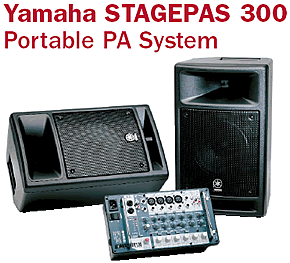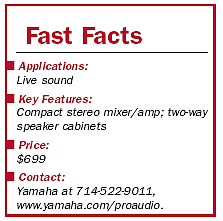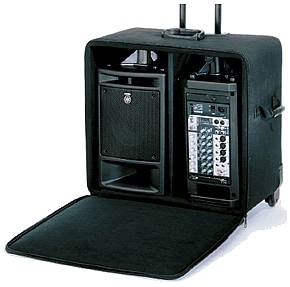STAGEPAS 300 (Pro Audio Review, August 2005)
| # |

|
By Bob Kovacs
Has the perfect portable PA system for the solo performer been invented? I've tried a few and even pieced together systems on my own, but there is always something lacking. However, the Yamaha STAGEPAS 300 is nearly perfect for this application, so close that I could probably live with its few limitations.
FEATURES
Unlike some other portable PA systems,
the $699 Yamaha STAGEPAS 300 consists
of two identical but separate speaker cabinets
that do not clamp together or attach in
any way. The speaker cabinets, measuring
about 18 x 11 x 10 inches (H x W x D), are
made from a tough black composite material
that gives them a serious heft.
Unlike some other portable
PA systems, the $699 Yamaha STAGEPAS 300 consists of two identical
but separate speaker cabinets that do not clamp together or
attach in any way. The speaker cabinets, measuring about 18
x 11 x 10 inches (H x W x D), are made from a tough black composite
material that gives them a serious heft.
Fitting neatly into a compartment
on one of the speakers is a nifty mixer/power-amp module that
locks into place with two positive-feeling screwhead latches.
The other speaker has a plastic cover that attaches with similar
latches. Since both speakers are identical, either one can hold
the mixer/amplifier module and the other can be used to store
the supplied speaker and power cables.

|
And it is a competent little mixer/amplifier.
Sporting eight inputs, the mixer has
four balanced/unbalanced mic/line inputs
(inputs 1-4) and two stereo inputs (inputs
5/6 and 7/8). Each input has a low and high
EQ pot, a level pot and the four mono
mic/line inputs have reverb select switches,
which are then controlled by a master reverb
pot. The EQs are fixed-frequency shelving
filters providing +/- 15dB of shelving at 100
Hz and 10 kHz.
The output "strip" has a five-LED level
meter, a master level pot and an interesting
Speech/Music switch that selects between
a punchy frequency response for speech
intelligibility and a flatter response curve
for music. There are two (left/right) outputs
for the STAGEPAS 300's non-powered
speakers and two sets of line level outputs
for recording and powered monitor
speakers. This monitor output pair has its
own level control.
The connectors are a mix of XLR, 1/4-
inch unbalanced and RCA jacks, logically
chosen for the most likely use of this sys-
tem. Off to one edge of the mixer/amp
module are a standard three-pin power
connector and a solid-feeling on-off
switch. Two heavy steel handles protect
the face of the mixer, minimizing the likelihood
that a knob will break if the unit
falls off a tabletop.
The amplifier claims a rather optimistic
maximum power of 150W per channel into six ohms, but a more reasonable expectation
is 100W per channel. This is still a remarkable rating for a mixer/amplifier module
that weighs a mere five pounds or so. The mixer/amp has a fan that makes a soft whine
when the unit is powered up.
IN USE
The Yamaha STAGEPAS 300 is built like
the audio equivalent of a fallout shelter,
which is the first thing about it that I found
endearing. Each speaker cabinet feels
exceptionally solid, resulting in punchy, resonance-
free bass.
The mixer/amp module nests firmly into
the speaker, giving the electronics more
protection from brick-fisted helpers you're
likely to find at bar gigs. You can use this
sound system with the mixer/amp either on
or off one of the speakers; I had it removed
for my use.
Just testing the Yamaha STAGEPAS 300
I found that the tweeters seemed to have a
rather narrow axis. However, the sound was
impressively balanced when I was on axis,
with tight bass and clean highs. Mid-bass
was just right for male vocals.
The proof of this system for me was a
performance at a nearby park, in a spacious
band shell and an audience area of about
300 seats. I played a solo gig on a steamy
morning, with my acoustic/electric guitar
plugged into one input and a vocal mic in
another. Achieving the right mix literally
took a couple of seconds, as this system is
perhaps the easiest to adjust that I have
ever used.
Although I didn't fill all the seats, this
Yamaha system did an excellent job of projecting
the sound to the last row; a listener
in the back row commented that he could
hear everything clearly. The volume even
attracted the attention of a few joggers in
the park and the built-in reverb added a little
interest to the sound of my guitar.
Setting up the system for a performance
took me no more
than two minutes before I was
ready to roll, including a
vocal mic and plugging in my
guitar. The mixer's layout and
operation are completely intuitive
and natural.
SUMMARY
The Yamaha STAGEPAS
300 is a cool system. It's
solid enough to withstand a
lot of abuse, powerful enough
to fill the typical bar or small
church, simple enough to use
with two-minutes'
practice and flexible enough to handle both
speech and performance applications.

|
In an ideal world, I'd like to see more
delay effects and the ability to feed a small
monitor speaker, but the STAGEPAS 300 is
rock solid and may be the best there is for
active solo performers.
Bob Kovacs is an engineer
and singer/guitarist. He can be reached at pvreditor @yahoo.com.
Copyright 2005 JRS Publishing (USA), Inc. Reprinted with permission.
Reprinted from Pro Audio Review
Reprinted from Pro Audio Review
